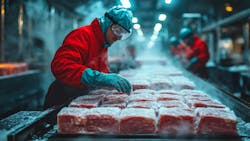Key Trends in Temperature-Controlled Logistics
As US temperature-controlled logistics operators look to the opportunities and challenges of the coming decades, the industry is preparing for and investing in a thriving, resilient and sustainable future. A number of key trends have emerged which are shaping the direction of the perishable food supply chain.
Growing Demand
The dominant long-term trend in the cold chain, both in the US and globally, is one of increasing demand and industry growth. This trend is forecast to continue just as strongly over the coming decades as temperature-controlled storage and transportation are increasingly recognized as critical infrastructure for food supply, as populations change and climatic conditions become more unpredictable.
The US cold chain is responding with investment into new state-of-the-art sustainable facilities, refurbishing and expanding existing facilities, investing in innovation and new technologies such as automation for efficiency, and investments into modern refrigerated vehicle fleets.
This action will help ensure cold chain capacity increases to meet growing demand and continues to facilitate the storage and transportation of safe, cost-effective, high quality perishable goods alongside a relative decrease in carbon footprint. The Global Cold Chain Alliance (GCCA) is engaging with government for a policy environment which supports and encourages this investment into sustainable cold chain growth.
Energy Efficiency
Using energy efficiently has risen up the agenda for many industries in recent years, driven by energy price volatility, corporate social responsibility (CSR) and increasingly stringent regulation. In an industry for which significant energy use to maintain low temperatures is fundamental to its operation (energy is cold storage’s second largest expense after labor), this focus on energy efficiency has been particularly important.
Temperature-controlled logistics operators are implementing a range of actions for better energy efficiency. The insulation and sealing of cold store building envelopes are being improved, and the use of space within cold stores is being maximized. Equipment maintenance programs are being revisited and equipment is being upgraded for better energy efficiency, with new and emerging energy-saving technologies such as automation increasingly adopted. Operators are capturing, monitoring and analyzing energy data to identify opportunities to reduce energy wastage. Many cold chain sites are investing in renewable energy generation, particularly solar technologies. Operators are delivering regular energy efficiency training for their workforce and embedding energy efficiency in organizational culture.
The results are impressive. More than 200 temperature-controlled warehouses have now been awarded an Energy Excellence level of bronze or higher through GCCA’s Energy Excellence Recognition Program (EERP), which helps businesses measure and improve cold store energy efficiency using qualitative and quantitative assessment tools.
As a result, the carbon impact of supply chains is being reduced through highly efficient operations. In addition, the perishable goods supply chain is gaining greater resilience to energy shocks, can minimize price increases, and is providing better temperature tracking data for products.
Sustainability
Another sustainability focused trend we can expect to feature prominently over the coming decade is the decarbonization of cold chain transportation. As well as moving away from fossil fuels in the main vehicle engines, cold chain logistics has the added challenge of switching to alternative fuel sources for the Transport Refrigeration Units (TRUs) on temperature-controlled vehicles.
The potential for reducing GHG emissions and cost efficiency is sound; however, it is crucial that the transition is managed appropriately. Alternative TRU technologies are still in development, or in trial or early adoption phases, and the extensive charging infrastructure that will be required is far from in place. GCCA continues to engage with government to emphasize the need for a measured and supported transition that does not put at risk the capabilities and resilience of the food supply chain.
Skills
The logistics industry is vulnerable to challenges around recruitment, and the cold chain has specialist skill and training requirements. The specialist skills and training needed are changing as the industry evolves, and as technologies such as automation, robotics and data analytics play an increasing role in temperature-controlled logistics operations.
The cold chain is investing substantially in future talent and future skills. Many larger businesses run their own internal training programs, and each year hundreds of cold chain professionals across the world join GCCA’s Cold Chain Institute. This unique educational program—a comprehensive three-year course that provides students with the knowledge and tools to enhance their individual specialty while developing a 360-degree understanding of the temperature-sensitive industry—marks its 60th anniversary in 2025. GCCA is urging the US Government to ensure that the industry’s investment in future skills for a sustainable and resilient food supply chain is supported and encouraged by policies, regulations, and relevant skills and recruitment programs.
Global Trade
An emerging trend we can expect to see increase in significance for temperature-controlled logistics over the course of 2025 is the impact on the US and global food supply chains of a shifting international trade landscape. At the time of writing, new US tariffs on Mexican and Canadian goods have been announced but suspended perhaps until April 2025, while additional tariffs on imports to the US from China are now in force with retaliatory tariffs on US exports into China due imminently. President Trump has also suggested the possibility of additional tariffs on goods from other regions such as the European Union.
As the impacts of higher tariffs, changing international relationships and uncertainty begin to take effect, the perishable food supply chain could be among the most disrupted. Shifts in trading routes could lead to significant reshaping in the food industry, as producers and retailers think differently about how and where to source food supplies. If global trade takes a more protectionist approach, effective and resilient cold storage and refrigerated transportation networks will become even more important for both national and international food supply chain resilience.
About the Author

Shane Brennan
senior vice president for strategy, partnerships and policy
Shane Brennan is senior vice president for strategy, partnerships and policy with the Global Cold Chain Alliance (GCCA), an organization that represents all major industries engaged in temperature-controlled warehousing, logistics and transportation.
